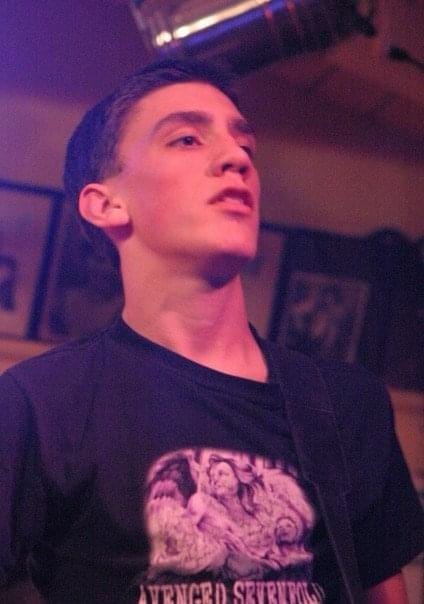Johannes Lichtman revisits his time on the suburban Los Angeles screamo circuit: ‘It wasn’t weak to sing about your feelings if, while you sang, muscled dudes were beating the shit out of each other in the mosh pit.’
Paid subscriptions — $5 per month, $50 per year — are what keep Tracks going. Consider upgrading. If you already have: thank you!
From 2002 to 2008 I played guitar in bands. My first show was in a backyard in Ventura County. I was 16 and co-lead guitarist in a screamo band. You cannot find the name of this band online, and, since I would rather the internet have access to my social security number than to my early musical output, it will remain unnamed. Our set had six songs: four originals and two Thrice covers. Thrice was our inspiration. They inspired us so much that we had to configure the set so that our best original song wasn’t too close to our cover of Thrice’s “To Awake and Avenge the Dead,” since our best original song was a rip-off of “To Awake and Avenge the Dead.”
Our singer lost his voice during the second song — poor screaming technique, nerves — and we never recovered. In the middle of the set, someone drunkenly staggered onto the stage, grabbed the microphone, and yelled, in a fake German accent, “Ladies and gentlemen, from Dusseldorf, Germany, I present to you: No Remorse!” Friends would later cite this as the highlight of the performance.
But we played more shows. The emo/metalcore scene was big in the suburbs of LA: Atreyu, Avenged Sevenfold, Bleeding Through, Eighteen Visions, Thrice, Throwdown (and, also, Hoobastank?). Teenagers were hungry for dramatic emotion expressed through guttural screams, and it wasn’t hard to book shows. Over the next few years we played at the Whisky, the Roxy, and the Malibu Inn, plus many now-defunct little clubs like the Cobalt Cafe, the Zen Lounge, and the Cat Club. The best shows were not at the famous Whisky or any of the other aging Sunset Strip clubs, where you had to buy 60 tickets from the club and then sell them yourself, but at The Kung Fu Corner, a martial-arts gym in a strip mall in Thousand Oaks.
We got better. Our singer learned how to scream without losing his voice. People stopped stealing the microphone and saying that we were a German metal band called No Remorse. We opened for From First to Last, whose singer went on to become a DJ named Skrillex. We opened for Curl Up and Die, whose singer went on to become nothing of note. But he got kicked in the face during the show and finished with blood gushing from his eye — something I’ll remember long after I’ve forgotten about Skrillex.
None of it would’ve happened if it weren’t for Thrice. I can’t remember who burned me my first copy of The Illusion of Safety, but I can still see their handwriting, block letters in Sharpie. “To Awake and Avenge the Dead,” my favorite song on the album, wasn’t doing anything particularly new. But in 2002 it was new to me. There was heavy aggression (metal-style riffs and machine-gun kick drum bursts), plaintive yearning (pop-punk vocal melodies), and then, on top of it all, more aggression (throat-shredding screaming). I hadn’t known, until then, that you could be so hardcore and so nakedly emotional at the same time. It was exciting.


I loved music but had never fit into punk or metal (or my body, my environment, my school, my mind, etc.). The version of masculinity that surrounded me said I wasn’t supposed to express my feelings. But I was having a lot of feelings. I was in love with everyone! I was sad about everything! And here was a way to feel all of that without looking like, in the charming parlance of the day, a pussy. (A word that, at least in my memory, was yelled at me several times a week from ages 14 to 22.) It wasn’t weak to sing about your feelings if, while you sang, muscled dudes in tight black tees were beating the shit out of each other in the mosh pit.
Dustin Kensrue, Thrice’s singer, always sounded like he was hurting — but never like he was going to cry. What was “To Awake and Avenge the Dead” about? I saw you killing Aristotle / I know it’s all part of the plan. No clue. There was a death; it would be avenged. In 2002 I didn’t reflexively pull out my phone to find out what songs were “really” about.1
“To Awake and Avenge the Dead” was about whatever I was feeling that day. And it fucking rocked. ✹
Johannes Lichtman is the author of two novels: Such Good Work (2019) and Calling Ukraine (2023).
(If you buy a book using a link from a Tracks essay, I receive a small commission.)
Also:
It’s not too late …
… to read old Tracks installments. Like Joanna Frieda Mulder on Sara Groves, finding and leaving Christianity, and living with loss. Or yours truly on 19 years of listening to different versions of Broken Social Scene’s “Superconnected,” which sometimes seems to be an ecstatic ode to friendship, but might “really” be about suicide.
Of course, things are different now. I learned things on my phone while writing this. Like: Thrice was Christian? What? And: Underoath was Christian? And: Norma Jean, the Georgian metalcore band whose tee shirt I wore for years, even after it stopped fitting, was Christian?!




Christianity 🤝 metalcore
It all blends and overlaps and surprises us, doesn't it? I don't think any of this music ever reached my 68 year old ears, but it certainly enriched YOUR life. This is a wonderfully evoked snapshot.
I get it!